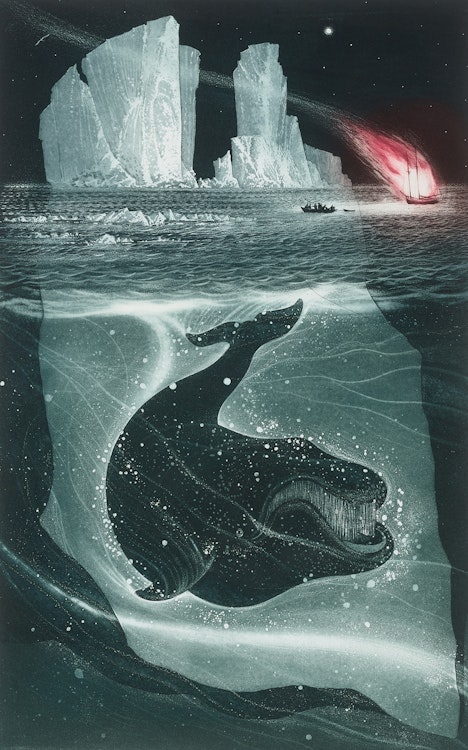Fire Down on the Labrador by David Lloyd Blackwood

David Blackwood
Fire Down on the Labrador
colour etching and aquatint
signed, titled, dated 1980 and inscribed “Artist’s Proof 5/10 Ed. 50” in the lower margin
31.75 x 19.75 ins ( 80.6 x 50.2 cms ) ( subject )
Auction Estimate: $25,000.00 - $30,000.00
Price Realized $48,300.00
Sale date: May 25th 2017
The Brock Street Gallery, Kingston
Private Collection, Kingston
Sean T. Cadigan, Black Ice: David Blackwood, Prints of Newfoundland, Toronto, 2011, page 75
Leah Sandals, “Black Ice: Q&A with David Blackwood”, National Post, March 7, 2011
William Gough, David Blackwood, Master Printmaker, Vancouver/Toronto, 2001, page 104
The narrative in this etching is rooted in a grease fire in the gallery of a schooner, which is the only fear these men would have had. In an interview, Blackwood remarks that “The wind, the ice, the tide - all seemed to be manageable. But you would never go to sleep at night until you'd made sure that there were no glowing embers in the stove.” The artist, a Newfoundland native, was raised in a seafaring family in which his father and grandfather were both ship captains. As such, Blackwood is completely aware of this fear ingrained in every mariner's conscience. He describes how this catastrophe would unfold for the crew in a 2010 interview with Gary Michael Dault: “…And then you’d be facing the worst possible scenario, the thing that was the greatest fear of all – to be caught in the Labrador Sea all alone, and having to abandon… So in my print “Fire Down on the Labrador”, it’s the ultimate disaster that I’m depicting – to be caught in that environment, and having to abandon ship.”
Share this item with your friends
David Lloyd Blackwood
(1941 - 2022) OSA, RCA, Order of Canada
Born in Wesleyville, Bonavista Bay, Newfoundland, one of the major sealing towns of that province, he is a descendant of a long line of master mariners. Blackwood was awarded a Government of Newfoundland Centennial scholarship to study at the Ontario College of Art in Toronto under Carl Schaefer, John Alfsen, H.W.G. MacDonald and Frederick Hagan. He went on to become Art Master at Trinity College School in Port Hope, Ontario. In 1969, Blackwood became the first artist-in-residence at Erindale College, University of Toronto, Mississauga.
David Blackwood uses his background on the East coast of Canada to create grande visual narratives reflecting both the landscape and culture of the province with an emphasis on combining the history, legends, and myths of settlement and developing culture of Newfoundland. He is best-known for his colour etchings with aquatint. His work was used to provide illustrations for Farley Mowat’s “Wake of the Great Sealers”, a collection of stories about the heroic Newfoundlanders who braved the icy seas of the treacherous North Atlantic in search of seals. Driven by hard times at home it was the only hope many of the men had of making money to feed their families. Men perished when their ships went down during wintry gales. Blackwood, a native of a sealing town himself, and a descendent of fishing skippers and sealing captains, provides Mowat’s stirring text with equally stirring and poetic figurative drawings and prints.
Blackwood was awarded the Order of Canada in 1993 in recognition of his work contributing to and preserving the cultural life and heritage of Canada through his artwork. At the Art Gallery of Ontario, the Blackwood Research Centre within the Morin Gelber Print and Drawing Centre was created after a major acquisition of the artists works in 2000. The museum also elected Blackwood as its honourary Chairman in 2003, the first practicing artist to hold this position. In the same year, he was awarded the Order of Ontario.
As one of Canada's most celebrated print-makers, David Blackwood's works are part of significant Canadian and international private and corporate collections including The Royal Collection, Windsor Castle, the Uffizi Gallery, Florence, the Art Gallery of Ontario and the National Gallery of Canada.
Sources: "A Dictionary of Canadian Artists, Volume I: A-F", compiled by Colin S. MacDonald, Canadian Paperbacks Publishing Ltd, Ottawa, 1977

